Featured Application
The engineering framework presented in this paper provides a validated, practical, and replicable methodology for the safe transport of large-scale, vibration-sensitive cultural heritage. The integrated approach, combining passive wire rope isolators with an active, real-time vibration monitoring and alert system, offers a robust solution for museums, conservators, and specialized logistics providers to mitigate the significant risks associated with relocating invaluable and fragile artworks.
Abstract
The transportation of large murals with significant historical and cultural value presents a considerable challenge due to their high susceptibility to damage caused by mechanical vibrations. This article presents a study on the design, implementation, and evaluation of an advanced wire rope isolator system, complemented by vibration sensors equipped with indicator lights for real-time monitoring. The research focuses on the case study of the relocation of Diego Rivera’s mural “Pan American Unity” from the City College of San Francisco to the San Francisco Museum of Modern Art (SFMOMA). The study observed a reduction in vibration transmission to the mural panels, achieving vibration attenuation of up to −20 dB in the critical 10–30 Hz frequency band during transportation. It was also found that the implementation of real-time monitoring with indicator lights alerted operators and conservators to critical vibration levels, enabling immediate intervention.
1. Introduction
The preservation of cultural heritage of significant scale and incalculable value represents a complex, multidisciplinary challenge at the intersection of conservation science and applied engineering. The undesirable effect of vibrations on museum artworks has been studied previously [,]. Damage caused by other sources of vibration, such as buildings near museums, has also been studied [,]. This damage has been characterized using everything from conventional accelerometers and hammers to modern measurement systems using piezoelectric materials [].
A particularly high-risk operation is the transportation of monumental artworks [], such as large-scale murals. During transit, the inherent structural fragility of these pieces is exposed to dynamic loads and transient vibrations [,]. These vibrations, spanning a broad spectrum of frequencies [], can initiate and propagate micro-cracks, cause delamination of pictorial layers, and ultimately lead to irreversible damage [,,]. Consequently, the development and rigorous validation of advanced engineering solutions to mitigate these transit-induced risks are of paramount importance for the global conservation community.
The current state-of-the-art in the protection of cultural assets during transport has increasingly focused on the application of vibration control principles []. Initial research has established the critical need for vibration monitoring, employing techniques such as digital holographic speckle pattern interferometry to characterize the effects of transport on artworks like canvas paintings [,,], while other work has focused on optimizing object positioning [] or integrated isolation systems like particle damping []. A notable benchmark in this field is the work conducted by the British Museum on protecting collections using custom-designed transport crates featuring wire rope isolators []. These passive devices are effective because they leverage the hysteretic damping properties of steel cables to dissipate vibrational energy [,,].
However, a significant gap remains in the literature concerning the application and quantitative performance analysis of these systems when scaled to protect monumental, planar structures such as murals, which possess unique dynamic characteristics and failure modes compared to three-dimensional museum objects.
To further contextualize this gap, it is important to note recent advancements in the broader field. Current research is exploring complex semi-active [] and active vibration control systems [], which can adapt their damping properties in real-time [] or canceling out the disturbance vibration by creating an opposite vibration []. There are also works that developed monitoring of cultural relics using blockchain and IoT []. While these active and predictive technologies represent the state-of-the-art, their complexity and specific applications make them prohibitive for many cultural heritage projects. Our study, therefore, addresses a critical gap by validating a robust, specific, and practical framework that integrates passive isolation with an accessible real-time feedback mechanism.
This paper presents a detailed case study on the successful implementation of an integrated vibration protection strategy for the relocation of Diego Rivera’s monumental mural, “Pan American Unity.” This mural is constructed with a unique blend of materials whose mechanical properties are not documented in the literature, as is the case with other murals around the world []. Other transfers of smaller murals have been reported []. The contribution of this work is twofold. First, we detail the design and application of a passive vibration isolation system based on wire-rope isolators, engineered specifically for the mural’s structural parameters. We present a rigorous quantitative analysis of the system’s performance by evaluating its transmissibility, a key engineering metric that characterizes isolation effectiveness across the frequency spectrum. Second, we introduce a novel, low-cost, real-time monitoring and alert system [], designed to provide immediate, actionable feedback to transport operators and conservators, thereby closing the loop between passive protection and active risk management. This was achieved with an array of accelerometers, different arrays of accelerometers have been used in the literature for bridge monitoring [] and bearing monitoring [], just as human-in-the-loop control is proven in applications such as truck control [], and rehabilitation devices control [].
This study presents, for the first time, a quantitative validation of a passive isolation system using wire rope isolator for a monumental mural, combined with a real-time, human-in-the-loop monitoring system. This is a novel methodological framework for the conservation of cultural heritage. The full experimental methodology, instrumentation details, and data analysis are presented to ensure the results can be reproduced and the approach adapted for future cultural heritage preservation projects. The subsequent sections detail the materials and methods, present the results of the vibration analysis, discuss the implications of the findings in the context of the wider conservation field, and offer conclusions on the effectiveness of the implemented solution.
2. Materials and Methods
2.1. The Mural “Pan American Unity” by Diego Rivera
The mural “Pan American Unity” was painted by Diego Rivera for the Golden Gate International Exposition on Treasure Island, San Francisco, in 1940. It is the largest contiguous mural created by the artist and the last one he painted in the United States. In 2021, it was relocated from the lobby of City College of San Francisco to the San Francisco Museum of Modern Art (SFMOMA). The city, characterized by its hilly terrain, is renowned for its steep and winding streets. Although the mural was designed in modular sections for transportation, it remains one of the thinnest murals in the world and was mounted on a 1.3 m thick concrete wall at City College. This complexity heightened the challenges of dismantling and transporting the mural, necessitating practical engineering solutions under these conditions. The mural is shown in Figure 1.

Figure 1.
Pan American Unity Mural by artist Diego Rivera.
The mural has a total dimension of 22.5 m in length and 6.7 m in height, with a total weight of 30 tons. It consists of 10 panels arranged in two rows and five columns, as shown in Figure 2. The upper panels are larger than the lower ones. To identify them, the upper panels are designated as (U) with dimensions of 4.5 m by 4.5 m each. The lower panels are designated as (L) with dimensions of 2.2 m by 4.5 m each. They are numbered from 1 to 5. Each of these panels is supported by a metallic structure made of steel beams, onto which a metal mesh is mounted, and finally, the pictorial layer is applied. The panels were embedded in a concrete wall as illustrated in Figure 3.

Figure 2.
The mural is composed of 10 panels: 5 square upper panels and 5 rectangular lower panels. Its dimensions and size in comparison to the average human are visible.
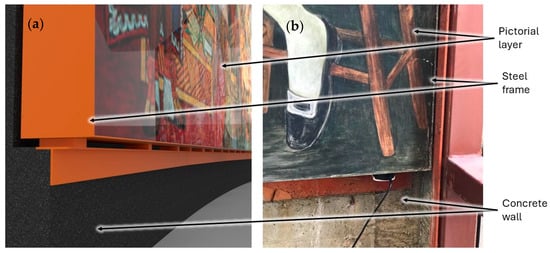
Figure 3.
Three-dimensional model (a) and photograph (b) showing the pictorial layer mounted on the steel frame embedded in the concrete wall.
The metallic structure of each panel consists of a 6-inch C-beam frame oriented with the channel facing inward, arranged vertically and evenly spaced are three slotted H-beams with slots and die cuts, there are also eight 1.5-inch C-beams placed vertically. As for horizontal elements, the upper panels have three 3-inch C-beams (one in the case of the lower panels). Finally, there are two 1.5-inch angles arranged diagonally to form an X in each panel. Details of their constitution and images of the assemblies are shown in Figure 4.

Figure 4.
Metal structure of the upper panels (a) and lower panels (b). Close-up of a corner of the structure (c), where the assembly of the steel profiles can be better appreciated.
The mural’s stratigraphy is a complex, multi-layered system built upon a foundational steel structure. A metal mesh is affixed to the frame, onto which four distinct mortar layers are applied.
The grout/cement layer (6.8–15 mm thick) is composed of Portland cement, aquarium silica sand, and vegetable fiber in a 1:2.5:0.03 ratio by parts. This is followed by three successive fresco layers, each with a unique formulation:
The rough fresco layer (10–15 mm thick) consists of white Portland cement, slightly dolomitic lime putty, vegetable fiber (1–3%), and a coarse marble powder graded with a composition of 20% at 4–150 µm, 40% at 300 µm, and 40% at 600 µm.
The medium fresco layer (5–8 mm thick) is composed of lime putty and medium marble powder in a 1:2 ratio by parts, with 1% vegetable fiber. The marble powder is graded with 60% at 4–150 µm, 30% at 300 µm, and 10% at 600 µm.
Finally, the intonaco layer (3 mm thick), upon which the painting is executed, is made of lime putty and fine marble powder in a 1:1 ratio, with the powder being 100% within the 4–150 µm range.
Given that the artist, Diego Rivera, was renowned for his idiosyncratic fresco formulas, which are not easily replicable and whose mechanical properties are undocumented, a full-scale mock-up was fabricated to mirror this specific composition. As depicted in Figure 5, this allowed for a cross-sectional display of the layers and served as the basis for the destructive testing necessary to define the system’s operational safety thresholds.
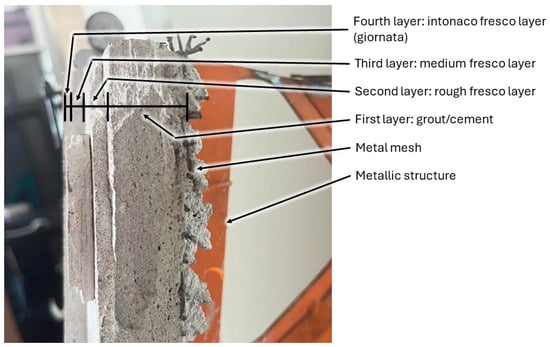
Figure 5.
Layers of the Pan American Unity mural. Cross-sectional view of the layers of Diego Rivera’s mural. This photo was taken of the full-size mock-up panel after destructive testing.
The panels were transported using a low-bed truck and a support structure known as a “travel frame.” Cranes and a multidisciplinary team of experts were employed to execute these maneuvers.
2.2. Panel Instrumentation
To measure vibrations in the mural panels, five piezoelectric accelerometers model MinIMU-9 v5 (Pololu Robotics & Electronics, Las Vegas, CA, USA) were strategically placed on the pictorial layer to capture the panel’s key dynamic behaviors, one in each corner to capture upper and lower accelerations and another in the center, as depicted in Figure 6. These were labeled SR1 to SR5, with SR5 located precisely at the center of each panel, where the out-of-plane vibratory amplitude is greatest. The accelerometers were mounted on the pictorial layer using cyclododecane, an organic compound that is solid at room temperature and soluble in organic solvents, thereby minimizing damage and preserving the integrity of the pictorial layer. Data from each sensor was collected at a resolution of 16 bits and a frequency of 200 Hz, according to the Nyquist theorem, this provides a theoretical maximum observable frequency of 100 Hz and a reliable analysis bandwidth of approximately 50 Hz. As confirmed by our subsequent PSD analysis, this range comprehensively covers the entire spectrum of significant energy for road-induced vibrations, which predominantly occur below 30 Hz.
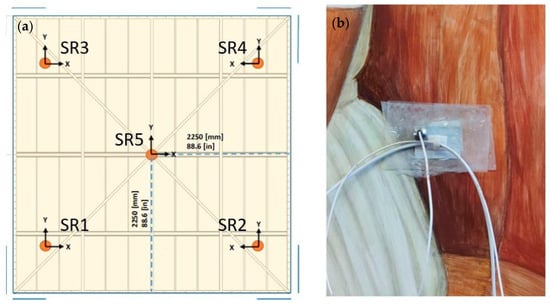
Figure 6.
Layout of the five triaxial accelerometers (SR1–SR5) on a upper mural panel (a). This distributed configuration was essential for capturing the panel’s dynamic response, allowing for vibration measurement along different axes (longitudinal, transverse, and vertical) and providing the data necessary for a comprehensive dynamic analysis, photograph of an accelerometer placed on the pictorial layer (b).
These MEMS-based accelerometers were chosen for their compact size and sufficient bandwidth for the application, the primary analysis of transmissibility is a relative metric (a ratio of outputs), which inherently minimizes the effect of absolute calibration errors. The transport events were of short duration (hours, not days), making long-term sensor drift a negligible factor. All accelerometers used were factory-calibrated with a specified sensitivity of 100 mV/g ± 5%. Prior to installation, a simple tap test was performed on each sensor while connected to the data acquisition system to verify functionality and consistent response. Given the application-oriented nature of this study, the primary focus was on the magnitude of vibration attenuation rather than a rigorous statistical error analysis. However, the consistency of the data across multiple transport segments and the clear distinction between input and response signals, as shown in the PSD analysis, provide high confidence in the reported results and conclusions.
The Power Spectral Density (PSD) of the vertical acceleration signals was computed using Welch’s method, a robust technique for analyzing non-stationary vibration signals. The analysis was performed in MATLAB (vR2024B), utilizing a Hann window with a duration of 2 s (corresponding to 381 samples at the calculated sampling frequency). A 50% overlap between segments was used to reduce variance in the spectral estimate. The resulting PSD shows the distribution of vibration energy as a function of frequency.
2.3. Light Indicator to Alert Vibration Limits on the Panels
During the disassembly, transportation, and reassembly processes, the murals are subjected to undesirable mechanical vibrations. While human handling is conducted with great care, sensory perception alone is insufficient to identify appropriate ranges of vibratory amplitude or frequency. For this reason, a real-time vibration monitoring system was developed using the sensors mentioned in Section 2.2. A traffic light-type indicator was implemented to alert those involved in the handling process about the permissible vibration amplitude limits.
The developed system consists of a NODEMCU V3 microcontroller (Haitronic Technology, Hongkong, China) to receive information from accelerometers, a data storage box, and an LED matrix that can emit green, amber, or red light based on the detected vibratory amplitude levels. Green lights indicate that the vibration levels are acceptable, allowing the maneuvers to continue. Amber lights indicate that the vibratory amplitudes are approaching the permissible range and maneuvers should be carried out with greater care. Finally, red lights indicate that the vibratory amplitudes are outside the permissible range, and all maneuvers should be stopped gently to protect the integrity of the panels. Each color is divided into two levels and relates to the G forces as shown in Table 1 and to a proposed settling time for the mural. During the transportation maneuvers of the mural, three people monitored the traffic lights. The G acceleration ranges for each level were defined with the destructive tests performed on the full-scale mock-up mural. An image of the device is shown in Figure 7.

Table 1.
Vibration alert thresholds and their corresponding color codes for the real-time monitoring system. These frequency and amplitude values were strategically determined based on preliminary destructive tests conducted on a full-scale mock-up of the mural panel, ensuring the thresholds represent meaningful risk levels.
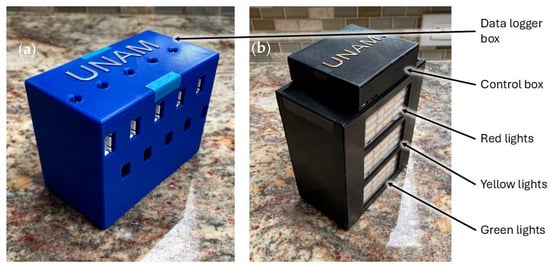
Figure 7.
Data logger (a) and light indicator to show vibration amplitude levels during maneuvers with the mural (b).
The frequency and amplitude thresholds for the alert system were established empirically, a necessity dictated by the unique and complex composition of the mural itself. The artist, Diego Rivera, was renowned for his peculiar fresco formulas, which are not easily replicable and whose precise mechanical properties and fatigue limits are not documented in engineering literature. This complexity precludes the application of standardized material failure data. Consequently, a series of controlled tests were performed on the full-scale mock-up panel, subjecting it to escalating levels of sinusoidal and random vibrations. The thresholds in Table 1 represent the empirically observed onset of visible micro-cracking. They are, therefore, not statistical fatigue analysis but are defined as conservative, single-event thresholds designed to provide an immediate safety margin against potentially damaging events during transit.
2.4. Wire Rope Isolators During Transport
To ensure the structural integrity of the mural panels during transport, a critical engineering task was the design of a vibration isolation system. The primary objective was to decouple the panels from the high-frequency vibrations generated at the truck bed interface. This is achieved by selecting isolators that shift the fundamental natural frequency of the panel-isolator assembly to a value significantly lower than the dominant forcing frequencies encountered during road transit. Helical wire rope isolators were specifically chosen due to their mechanical simplicity, low cost, quick manufacturing, and most notably, their hysteretic behavior, which offers advantages for this application. Alternative solutions, such as elastomeric (rubber) mounts, were considered but deemed less suitable due to their susceptibility to aging and performance degradation over time. Air-spring systems, while offering excellent low-frequency isolation, were dismissed due to their complexity, cost, and need for an active power source, which introduces additional points of potential failure. An image of the damper is shown in Figure 8. Four wire rope isolators were placed at the bottom of the panel and two at the top.

Figure 8.
Close-up of wire rope isolators assembled with the travel frame and panel (a), general view of the panel assembly, travel frame, wire rope isolators and transport truck before the trip (b).
The implemented wire rope isolator was based on a systematic analysis of load capacity and dynamic response. With a total mural weight of 13.98 tons distributed over 5 upper panels of 1837 kg and 5 lower panels of 959 kg. The transport configuration utilized ten isolators per panel, eight supporting the vertical load in compression (four in each side) and two providing lateral stability (one in each side), it is shown in Figure 8. The wire rope isolator possesses a maximum static load capacity of 17.8 kN (4000 lbf) per unit in pure compression. This provides a substantial safety factor of 7.9 for the upper panel and a safety factor of 15.13 for the lower panels.
From a dynamic perspective, the critical design parameter was the natural frequency of the entire isolated system (panel mass and isolator stiffness). The goal was to select isolators that would result in a system natural frequency significantly lower than the dominant road input frequencies (10–30 Hz). While the isolator’s datasheet provides a reference frequency of 3.4 Hz under ideal load, the key validation comes from the experimental results. As will be shown in the transmissibility analysis (Section 3), the actual measured resonant frequency of the system in situ was approximately 8 Hz. By successfully placing the system’s resonance at this low frequency, the design ensures that the higher, more energetic road frequencies operate well within the isolation region of the transmissibility curve, where vibrations are attenuated rather than amplified.
Furthermore, a key advantage of the selected wire rope isolators is their inherent hysteretic damping characteristic. Unlike ideal linear springs, the friction between the individual strands of the coiled steel cable provides a mechanism for energy dissipation over a wide range of frequencies and amplitudes. This non-linear behavior is particularly effective at attenuating both steady-state vibrations and transient shocks, such as those caused by potholes or abrupt changes in road conditions, thereby protecting the delicate fresco layers of the mural. A photo of one wire rope isolator is shown with its dimensions in Figure 9.
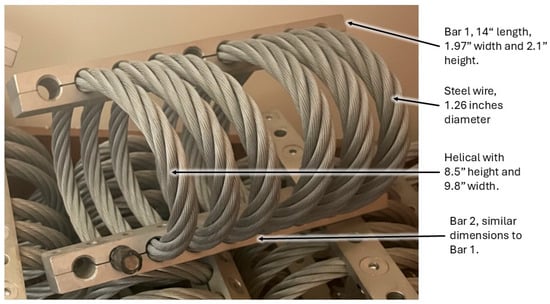
Figure 9.
Photo of the wire rope isolator showing its mechanical composition and dimensions.
3. Results
Figure 10 presents a comparative analysis of the time-history acceleration data recorded simultaneously from the truck bed (sensor R8, designated as the vibrational input) and the isolated mural panel (sensor S5, designated as the system response). The data is plotted for all three orthogonal axes (AX, AY, AZ) over the complete duration of the transport. A direct visual inspection of the plots reveals a significant attenuation of the vibration amplitudes in the panel relative to the truck bed. This reduction is consistently observed across all axes, but is most pronounced in the vertical axis (AY), which is primarily influenced by road surface irregularities. While the input signal from the truck (R8) is characterized by high-amplitude, transient spikes corresponding to shock events, the response signal from the panel (SR5) exhibits substantially lower peak accelerations and a smoother overall profile.
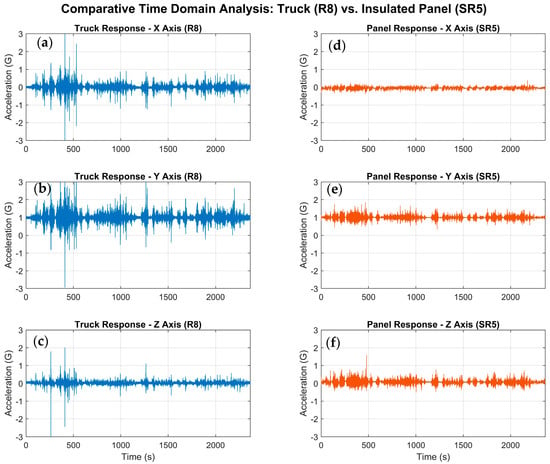
Figure 10.
Comparative time-history plot of accelerations. The graph clearly illustrates the primary finding of the study: a significant reduction in vibration amplitude between the input from the truck bed (a–c) and the response of the isolated mural panel (d–f), demonstrating the effectiveness of the isolation system.
To quantitatively assess the vibrational environment and the isolation system’s effect, a frequency domain analysis was performed. The Power Spectral Density (PSD) of the vertical acceleration signals (‘AY’ axis) for both the truck bed (input, R8) and the insulated panel (response, S5) was computed using Welch’s method, a standard and robust technique for analyzing non-stationary and random vibration signals, which are characteristic of road transport. Figure 11 presents the results. The input PSD from the truck bed exhibits a high energy content distributed across a broad frequency band, with dominant peaks observed between 10 Hz and 30 Hz. This spectral signature is characteristic of vibrations induced by road surface irregularities during highway transit. In stark contrast, the PSD of the panel’s response shows a significant reduction in spectral amplitude across this entire frequency range. This demonstrates that the vibrational energy reaching the artwork is substantially lower than the input energy from the vehicle, providing clear evidence of the system’s passive filtering capabilities.
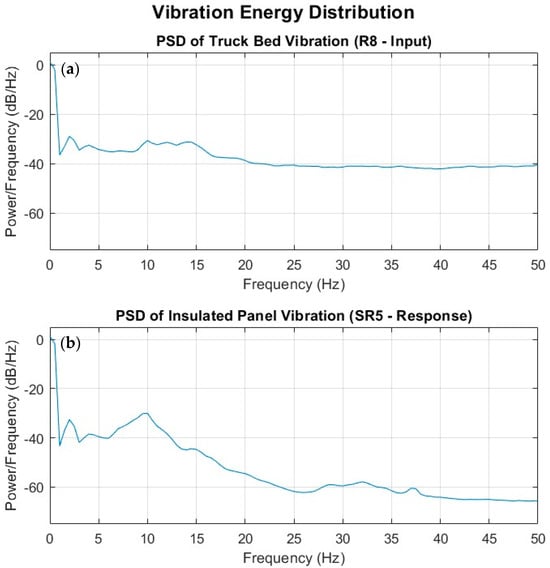
Figure 11.
Power Spectral Density (PSD) analysis of the vertical acceleration signals. The plot emphasizes the main finding in the frequency domain, showing that the high-energy vibrational content from the truck input (a) is substantially attenuated in the panel’s response (b), particularly in the critical 10–30 Hz range.
To rigorously quantify the performance of the wire rope isolation system, the transmissibility, T(f), was calculated as the ratio of the response PSD to the input PSD (PSDS5/PSDR8). The resulting transmissibility curve for the vertical axis is shown in Figure 12. The plot reveals several key performance characteristics. A primary resonant frequency is identifiable at approximately 8 Hz, where minor amplification occurs. However, for frequencies above approximately 10 Hz, the transmissibility curve drops consistently below the 0 dB threshold, entering the critical region of isolation.
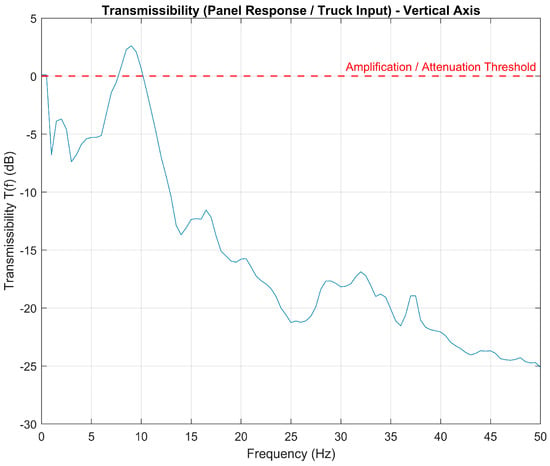
Figure 12.
Transmissibility plot for the vertical axis. The curve shows the ratio of panel response to truck input. Values below the 0 dB threshold indicate successful vibration attenuation. The system achieves significant isolation above 10 Hz, covering the most energetic frequency bands from road input.
Notably, within the dominant input frequency range of 10 Hz to 30 Hz, the system demonstrates a robust attenuation performance, achieving a transmissibility of −10 dB to −20 dB. A transmissibility of −20 dB corresponds to a 90% reduction in transmitted vibrational energy. This quantitative result confirms that the isolators were correctly specified to operate effectively against the most energetic vibrational components experienced during transport. The analysis validates that the isolation system successfully shifted the panel’s dynamic response away from the dominant forcing frequencies, thereby ensuring the structural integrity of the panels.
The real-time monitoring system served as a critical active feedback loop, complementing the performance of the passive wire rope isolators. During the transit of each panel, the amber alert threshold, calibrated to detect sustained vibrational energy in the 40–60 Hz range, was triggered an average of three times. Each activation prompted an immediate, pre-planned intervention by the transport crew, consisting of a reduction in vehicle speed until the system returned to a green-light status. This response protocol demonstrates a successful implementation of a human-in-the-loop control strategy, effectively altering the road-induced forcing frequencies in real-time to mitigate transient, high-energy events that could otherwise pose a risk to the artwork.
Ultimately, all panels were successfully transported and installed at the San Francisco Museum of Modern Art (SFMOMA) for exhibition. Figure 13 shows an image of the mural in its new location. This success not only highlights the effectiveness of the implemented damping and monitoring strategies but also underscores the importance of a multidisciplinary approach that combines engineering, conservation, and logistics for the protection of cultural heritage.

Figure 13.
Pan American Unity mural installed at SFMOMA.
4. Discussion
The quantitative results presented in the frequency domain provide a definitive validation of the implemented engineering strategy. The transmissibility analysis (Figure 12) serves as the core evidence of the system’s success, demonstrating that the wire rope isolators performed as theoretically expected.
It is observed a resonant frequency in 8 Hz approximately, then there is a evident reduction in vibration in the band 10–30 Hz, confirming a correct system design. Critically, the system achieved significant attenuation (up to −20 dB) in the 10–30 Hz band, which the PSD analysis (Figure 11) identified as the most energy-rich range for road-induced vibrations. This confirms that the isolation system was not only effective but was effective precisely where it was most needed.
Beyond the performance of the passive isolation, this study underscores the immense value of an integrated, human-in-the-loop monitoring system. While the isolators managed the steady-state and random vibrations, the real-time alert system provided a crucial layer of defense against transient shock events (e.g., potholes, abrupt braking). The activation of the amber alert, prompting a direct intervention by the crew, represents a successful mitigation of risk that a purely passive system could not address. This synergy between a well-designed mechanical system and an adaptive, real-time feedback protocol is a key contribution of this work, offering a practical and effective framework that bridges the gap between theoretical vibration control and the unpredictable realities of in-transit operations. When compared to other studies, such as the work by the British Museum [] on smaller, three-dimensional objects, our findings demonstrate that these principles can be successfully scaled to protect large, planar, and uniquely fragile structures like monumental murals.
It is important to acknowledge the limitations of this study to provide context for the generalizability of its findings. The results presented are based on a single, albeit comprehensive, case study under specific transport conditions (e.g., vehicle type, suspension characteristics, road quality in the San Francisco area). The performance of the isolation system could vary with different input vibration profiles. Furthermore, this study focused on the validation of a passive isolation system; its performance is inherently fixed and cannot adapt to low-frequency vibrations near its natural frequency. The real-time alert system, while effective, relies on human intervention, which introduces a variable response time.
From a practical implementation standpoint, it is important to consider the operational and economic aspects of this system. The primary cost is associated with the wire rope isolators, whose price scales with load capacity. While representing a significant investment, this cost is negligible when compared to the incalculable cultural and historical value of the artwork being protected. Operationally, the main constraint is the requirement for trained personnel to interpret the real-time alerts and execute the speed-reduction protocol. For smaller museum objects, a scaled-down version of this system could be highly effective; however, a cost–benefit analysis would be necessary to justify its implementation over traditional passive cushioning materials for lower-value artifacts.
This project establishes a robust, replicable methodology for the safe transport of large-scale cultural heritage. Based on the insights gained, future work should be directed towards the development of “smart transport” systems. This includes the investigation of semi-active or active vibration control systems to further improve isolation performance at low frequencies. Furthermore, the integration of machine learning algorithms to predict high-vibration events based on GPS route data and real-time sensor input could evolve the current reactive alert system into a predictive warning system, setting a new standard in the preservation of invaluable cultural assets.
5. Conclusions
This research successfully validated an integrated engineering framework for mitigating vibration risks during the transport of a monumental mural. The primary challenge was protecting a unique, irreplaceable structure whose complex material properties precluded the use of standard analytical failure models. By combining empirical testing on a full-scale mock-up with a robust passive isolation design, this study overcame this challenge, achieving a vibration attenuation of up to −20 dB in the most energetic frequency bands (10–30 Hz). The results quantitatively demonstrate that the system successfully isolated the artwork from harmful road-induced inputs.
More significantly, this work highlights the critical importance of a dual-pronged approach. The passive isolators managed the predictable, steady-state vibrations, while the active, human-in-the-loop monitoring system provided the necessary defense against unpredictable, transient shocks. It is important to take into account that the vision system is dependent on human attention; therefore, it is recommended that more than one person monitors the traffic light. This synergy proved to be a decisive factor in the project’s success.
While this project establishes a robust and replicable methodology, future work should focus on evolving this framework into a comprehensive “smart transport” system. Foundational to this effort would be a full Experimental Modal Analysis (EMA) performed on a new mock-up. Characterizing the panel’s precise vibration modes would enable the creation of a high-fidelity Digital Twin for pre-transit risk simulation and provide the necessary model for designing more advanced control strategies.
Building upon this validated model, the monitoring system could be enhanced by integrating machine learning algorithms. By leveraging GPS route data and real-time sensor input, the current reactive alert system could be transformed into a predictive one, capable of forecasting high-vibration events. Furthermore, complementary sensing technologies, such as piezoelectric or fiber optic strain sensors, should be explored to provide direct data on material deformation, which is more proximate to damage mechanisms. Ultimately, these advancements would pave the way for investigating semi-active or active vibration control systems to further improve isolation performance, particularly at the challenging low frequencies near the system’s resonance.
Author Contributions
Conceptualization, A.C.R.-R. and M.B.; methodology, D.A.Z.-G. and A.C.R.-R.; software, D.A.Z.-G.; validation, M.B., A.C.R.-R. and D.A.Z.-G.; formal analysis, M.P.C.-L.; investigation, M.P.C.-L.; resources, M.B.; data curation, M.P.C.-L.; writing—original draft preparation, A.C.R.-R. writing—review and editing, D.A.Z.-G.; visualization, D.A.Z.-G.; supervision, A.C.R.-R.; project administration, A.C.R.-R. All authors have read and agreed to the published version of the manuscript.
Funding
The authors thank the National Autonomous University of Mexico for the financial support to carry out this development through the PAPIIT UNAM (grant no. IT102122) with the name: “Diseño y construcción de un dispositivo y banco de pruebas para evaluar el daño efectuado a patrimonio cultural e histórico de México durante su desmontaje, preparación, traslado, montaje y exhibición”.
Institutional Review Board Statement
Not applicable.
Data Availability Statement
The datasets generated during and analyzed during the current study are available from the corresponding author upon reasonable request.
Acknowledgments
The authors thank the National Autonomous University of Mexico for the financial support to carry out this development through the PAPIIT UNAM (grant no. IT102122) with the name: “Diseño y construcción de un dispositivo y banco de pruebas para evaluar el daño efectuado a patrimonio cultural e histórico de México durante su desmontaje, preparación, traslado, montaje y exhibición”. The authors also extend our gratitude to the UNAM team: Anahí Velázquez Silva, Miguel Adrián Michel Juárez, Laura Elena Castañeda Dávila and Sandra Zetina Ocaña and the MOMA team: Kiernan Graves and Brayan Chaine. Diego Rivera, Unión de la Expresión Artística del Norte y Sur de este Continente (The Marriage of the Artistic Expression of the North and of the South on This Continent), also known as Pan American Unity, 1940. Courtesy City College of San Francisco; © Banco de México Diego Rivera & Frida Kahlo Museums Trust, Mexico, D.F./Artists Rights Society (ARS), New York.
Conflicts of Interest
The authors declare no conflicts of interest.
References
- Johnson, A.; Hannen, W. Vibration limits for historic buildings and art collections. APT Bull. J. Preserv. Technol. 2015, 46, 66–74. [Google Scholar]
- Thickett, D. Vibration damage levels for museum objects. In Proceedings of the ICOM Committee for Conservation 13th Triennial Meeting, Rio de Janeiro, Brazil, 20–27 September 2002. [Google Scholar]
- Kosikova, A.; de Lapérouse, J.F.; Seymour, M.; Smyth, A.; Brügger, A. Impact assessment of construction methods and support structures on vibration levels of ancient reliefs. npj Herit. Sci. 2025, 13, 272. [Google Scholar] [CrossRef]
- Xu, W.; Zhao, J.; Yang, W.; Yu, D.; Qiu, L.; Chen, Z.; Qiu, Y. The effects of construction vibration on stone cultural relics: A case study from the Qingdao Museum. Herit. Sci. 2023, 11, 250. [Google Scholar] [CrossRef]
- Castellini, P.; Esposito, E.; Paone, N.; Tomasini, E.P. Non-invasive measurements of damage of frescoes paintings and icon by laser scanning vibrometer: Experimental results on artificial samples and real works of art. Measurement 2000, 28, 33–45. [Google Scholar] [CrossRef]
- Hutchin, T.W.J.; Waters, T.P.; Kotonski, V. Shock and vibration response of museum objects during transportation. J. Phys. Conf. Ser. 2024, 2647, 222009. [Google Scholar] [CrossRef]
- Lasyk, Ł.; Łukomski, M.; Bratasz, Ł.; Kozłowski, R. Vibration as a hazard during the transportation of canvas paintings. Stud. Conserv. 2008, 53, 64–68. [Google Scholar] [CrossRef]
- Gao, Y.; Ziegler, P.; Hartlieb, E.; Heinemann, C.; Eberhard, P. Reproduction of transport-induced vibration of paintings based on a multi-channel FxLMS controller. Acta Mech. 2023, 234, 5369–5384. [Google Scholar] [CrossRef]
- Jarimopas, B.; Singh, S.P.; Saengnil, W. Measurement and Analysis of Truck Transport Vibration Levels and Damage to Packaged Tangerines during Transit. Packag. Technol. Sci. 2005, 18, 179–188. [Google Scholar] [CrossRef]
- Siami, A.; Karimi, H.R.; Cigada, A.; Zappa, E. Chapter 5—Vibration protection of cultural heritage objects. In Vibration Control and Actuation of Large-Scale Systems; Academic Press: Cambridge, MA, USA, 2020; pp. 107–156. [Google Scholar]
- Gruver, J. Art in Transit. Handbook for Packing and Transporting Paintings; National Gallery of Art: Washington, DC, USA, 1997.
- Wei, W.; Dondorp, E. Testing to Determine Allowable Vibration Limits at a Natural-History Museum in the Netherlands. APT Bull. J. Preserv. Technol. 2020, 51, 19–26. Available online: https://www.jstor.org/stable/26970189 (accessed on 20 September 2025).
- Kracht, K.; Kletschkowski, T. From Arto to Engineeering: A Technical Review on The Problem of Vibrating Canvas Part 1: Exitation and efforts of vibration reduction. Facta Univ. 2017, 15, 163–182. [Google Scholar] [CrossRef]
- Lauchli, M.; Baschlin, N.; Hoess, A.; Fankhauser, T.; Palmbach, C.; Ryser, M. Packing systems for paintings: Damping capacity in relation to transport-induced shock and vibration. In Proceedings of the ICOM-CC 17th Triennial Conference, Melbourne, Australia, 15–19 September 2014. [Google Scholar]
- Tsiranidou, E.; Bernikola, E.; Tornari, V.; Fankhauser, T.; Läuchli, M.; Palmbach, C.; Bäschlin, N. Preliminary investigation on monitoring transportation effects by full field methods: A digital holographic speckle pattern interferometry study on canvas paintings. In Proceedings of the SPIE 8084, O3A: Optics for Arts, Architecture, and Archaeology III, Munich, Germany, 23–26 May 2011. [Google Scholar] [CrossRef]
- Tornari, V.; Tsiranidou, E.; Bernikola, E. Crack-Growth on Canvas Paintings during Transport Simulation Monitored with Digital Holographic Speckle Interferometry. Adv. Res. 2014, 2, 967–986. [Google Scholar] [CrossRef]
- Génevaux, J.-M.; Dantec, B.L. Optimized anti-vibratory system for stretched canvas artwork hanging in a museum. J. Cult. Herit. 2014, 15, 382–390. [Google Scholar] [CrossRef]
- Xiao, W.; Lu, D.; Song, L.; Guo, H.; Yang, Z. Influence of particle damping on ride comfort of mining dump truck. Mech. Syst. Signal Process. 2020, 136, 106509. [Google Scholar] [CrossRef]
- Kotonski, V.; Kracht, K.; York, E.; Barton, C. Protecting Three-Dimensional Museum Collections During Transport: Engineering and Evaluation of Transport Crates Featuring Wire-Rope Isolators for Improved Vibration Mitigation. Stud. Conserv. 2022, 67, S130–S139. [Google Scholar] [CrossRef]
- Buzea, D.; Iacob, A.; Soimaru, C.; Ungureanu, L. Vibration Behavior Analysis of Wire Rope Isolators Under Traction and Compression Load. Appl. Mech. Mater. 2013, 332, 357–362. [Google Scholar] [CrossRef]
- Leblouba, M.; Balaji, P.S.; Rahman, M.E. Wire Rope Isolators for the Vibration Protection of Heavy Equipment: Exploratory Research. Buildings 2022, 12, 2212. [Google Scholar] [CrossRef]
- Fu, M.; Yang, Z. Stiffness Hardening Effect of Wire Rope Isolators under Small Cyclic Loads for Vibration Isolation. Materials 2024, 17, 4983. [Google Scholar] [CrossRef]
- Qu, D.; Liu, X.; Liu, G.; He, T. Vibration isolation characteristics and control strategy of parallel air spring system for transportation under abnormal road and eccentric load conditions. Meas. Control 2021, 54, 252–268. [Google Scholar] [CrossRef]
- Guo, Q.; Zhou, J.; Li, L.; Xu, M.; Tang, G. Design and Experimental Study of a Hybrid Micro-Vibration Isolation System Based on a Strain Sensor for High-Precision Space Payloads. Sensors 2024, 24, 1649. [Google Scholar] [CrossRef] [PubMed]
- Gao, Y.; Ziegler, P.; Eberhard, P. Reproduction of Transport-Induced Vibration Ofpaintings Through Multi-Channel Active Vibrationcontrol. In Proceedings of the Annual Congress of International Institute of Acoustics and Vibration (IIAV), Beijing, China, 9–13 July 2023. [Google Scholar]
- Forma, L.; Boutin, H.; Jossic, M.; Conte, S.L.; Wilkie-Chancellier, N. Vibrations and cultural heritage preservation: A new approach to protect objects. Eur. Phys. J. Plus 2023, 138, 310. [Google Scholar] [CrossRef]
- Zhang, J.; Guo, M.; Li, B.; Lu, R. A transport monitoring system for cultural relics protection based on blockchain and internet of things. J. Cult. Herit. 2021, 50, 106–114. [Google Scholar] [CrossRef]
- Zhang, Y.; Wang, J.; Zhang, T. Analysis on Mural Structures and Components of the Tombs in Liao Dynasty (A.D. 907–A.D. 1125). Spectrosc. Lett. 2015, 48, 732–740. [Google Scholar] [CrossRef]
- Hensick, T.; Sigel, A.; Lie, H.; Khandekar, N.; Smith, K.; Bewer, F.; Chang, A.; Orsini, L.; Mysak, E. Protection and relocation of frescoes during construction at the Harvard Art Museums. In Subliming Surfaces: Volatile Binding Media in Heritage Conservation; University of Cambridge Museums: Cambridge, UK, 2019; pp. 141–152. [Google Scholar] [CrossRef]
- Hassan, I.U.; Panduru, K.; Walsh, J. An In-Depth Study of Vibration Sensors for Condition Monitoring. Sensors 2024, 24, 740. [Google Scholar] [CrossRef] [PubMed]
- Coviello, C.G.; Rizzo, F.; Sabbà, M.F. Optimization of the Number of Accelerometer Placements for Dynamic Identification of a Historical Masonry Bridge. Infrastructures 2025, 10, 281. [Google Scholar] [CrossRef]
- Malusare, M.; Mahmud, M.; Wang, W. An Enhanced TK Technology for Bearing Fault Detection Using Vibration Measurement. Sensors 2025, 25, 6571. [Google Scholar] [CrossRef]
- Zhang, Q.; Zhao, A.; Zhao, F.; Wu, W. A Human-in-the-Loop Study of Eye-Movement-Based Control for Workload Reduction in Delayed Teleoperation of Ground Vehicles. Machines 2025, 13, 735. [Google Scholar] [CrossRef]
- Sang, M.W.; Narayan, J. Reinforcement Learning-Based Finite-Time Sliding-Mode Control in a Human-in-the-Loop Framework for Pediatric Gait Exoskeleton. Machines 2025, 13, 668. [Google Scholar] [CrossRef]
Disclaimer/Publisher’s Note: The statements, opinions and data contained in all publications are solely those of the individual author(s) and contributor(s) and not of MDPI and/or the editor(s). MDPI and/or the editor(s) disclaim responsibility for any injury to people or property resulting from any ideas, methods, instructions or products referred to in the content. |
© 2025 by the authors. Licensee MDPI, Basel, Switzerland. This article is an open access article distributed under the terms and conditions of the Creative Commons Attribution (CC BY) license (https://creativecommons.org/licenses/by/4.0/).